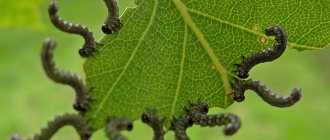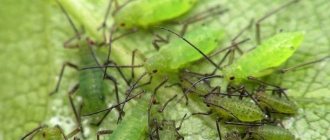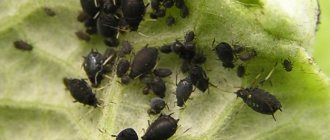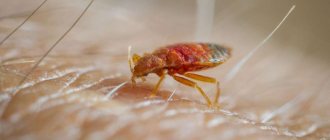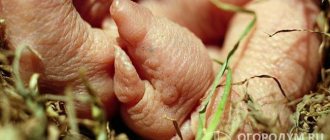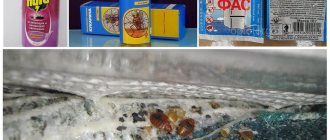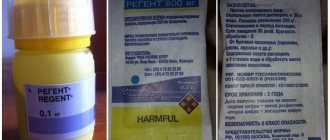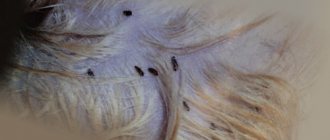Gooseberries are a favorite and healthy berry for many. Unfortunately, growing it is not so easy: almost all pests of open ground happily settle on this shrub. The most dangerous aphid is on gooseberries. A bush that has been attacked by it stops bearing fruit and may even die. Timely and comprehensive control of aphids can save the long-awaited harvest.
Signs of gooseberry aphid damage
After an attack by pests, the gooseberry stops producing the usual amount of harvest and loses its visual appeal - the leaves curl, wither, turn yellow, and dry out.
If you do not pay attention to these signs, the bush will die in the future. But not so much from larvae, but from black sooty mildew.
How to recognize a pest
Gooseberry or shoot aphids often settle on gooseberries . The larvae have a spindle-shaped shape, body length from 0.5 to 0.7 mm, light green color, glassy body. Individuals have large antennae and powerful jaws.
The presence of a colony on plants is recognized by the following signs:
- leaves begin to curl, deform, turn yellow and become a shelter for larvae;
- ants are active on the shoots;
- the bush was covered with a sticky coating with a gray tint.
At the end of the gooseberry flowering, winged female aphids begin to appear . They move to another part of the site or even to neighboring gardens, creating new colonies there. In the fall, eggs are laid again, from which new offspring will appear in the spring.
Damage caused
Adults do not harm crops. The larvae cause significant damage . They feed on the juice of plants and fruits. The gooseberry gradually fades, loses strength, and often dies.
Pests become carriers of sooty fungus . This in turn activates powdery mildew. First of all, the disease affects the lower part of the bush, then the upper shoots and fruits. The berries begin to deform, become smaller and dry out. In gooseberries, photosynthesis is disrupted and resistance to frost is reduced.
The aphid moves to neighboring crops : currants, apple trees, cherries, zucchini, etc. If its spread is not stopped in time, by the fall the gardener will lose up to 60% of the entire harvest.
Chemicals
Pesticides are used before the leaves appear or immediately after flowering. After all, insecticidal components can accumulate in all parts of the bush. Moreover, the required protective level of concentration of the product is maintained for 30 days. If this period coincides with the flowering time, the gooseberry pollen will be poisonous, resulting in the death of the bees. While the insecticide is in action, the gooseberries themselves are also unsafe. Therefore, when using chemicals, strict adherence to the manufacturer's recommendations is necessary.
Insecticides against aphids
On a note!
You can spray gooseberries with chemicals only before the first leaves appear and after harvesting.
The most popular drugs today are:
- Aktara remedy;
- Fitoverm;
- Spark;
- Tanrek;
- Fufanon;
- Arrivo;
- Inta-vir;
- Bi-58.
On a note!
Treatment with any of these preparations should be carried out in the evening in the absence of wind and rain, since most insecticidal components lose their activity at high temperatures.
Causes
There are several obvious reasons.
Among them:
- Metabolic disease. It occurs from an excess or deficiency of microelements (potassium and phosphorus) in the root system, the plant itself.
- Overgrown area. Failure to promptly remove weeds around plants leads to the appearance of various insects.
- A large number of anthills. Ants carry aphids, so they fight these two types of insects at the same time.
- The rules of agricultural technology were violated. This is the wrong choice of place for planting, deposits of fallen leaves, non-compliance with the irrigation regime.
How to deal with gooseberry moth
The appearance of pests is quite typical for gooseberries, and one of the most popular is the moth.
This small butterfly is very common in our area. The wingspan of this gooseberry pest reaches 3 cm. The butterfly is gray in color, and transverse brown stripes are clearly visible on its wings. It emerges from a deep green caterpillar whose pupa spends the winter in the top layer of soil. The butterfly appears in the spring, during the formation of buds. The female lays larvae in buds and inflorescences; as they grow, they eat away the pulp of the berries, as a result of which the fruits do not have time to ripen and dry out.
A characteristic sign of a moth “residing” on your plant will be the appearance of a white cobweb. To combat this gooseberry pest, you can use traditional methods and “chemical attack”. An effective means of control is digging up the soil under the bush, which is carried out in late autumn and helps destroy the pupae. Cleaning spider nests from branches and inflorescences will also be a good help for the bush.
No less effective is the protection of gooseberries using an ash solution applied to the bush during spring treatment. After flowering, you can spray the plant with insecticides, for example, carbolite, ethaphos, ambush.
Ways to get rid of aphids on gooseberries
Aphids are destroyed by chemical, folk, mechanical means and agrotechnical methods . If neighboring crops are already affected by the pest, they are treated simultaneously with the gooseberries.
Chemicals
Apply before the first leaves appear or after harvesting . Treatments should not be carried out during the fruiting period, as the berries will accumulate insecticidal components. It is not recommended to use pesticides during the flowering period: the pollen becomes toxic, causing the death of a significant part of the bees.
Important! Work with drugs wearing protective clothing, a mask and gloves. Be sure to read the manufacturer's advice. If it rains the next day after spraying, repeat the procedure.
"Aktara"
This is a new generation insecticide with a broad spectrum of action . Not dangerous for humans, animals, earthworms. It destroys aphids through the digestive system.
After treatment with Aktara, the protective properties remain for 15-30 days. Prepare a solution (2 g of the drug is diluted in 10 liters of water), spray the gooseberries with it. The procedure is carried out in the evening in dry and windless weather. If the aphids have not retreated, repeat spraying after 7 days.
"Fitoverm"
This is a biological insecticide made from waste products of soil microorganisms . It is a broad-spectrum drug and is not considered dangerous for other crops.
The solution is prepared before use: dilute 2 ml of the drug in 1 liter of water, mix thoroughly for a minute. Spray the bushes in the evening. If the mixture interacts with sunlight, its properties will be lost.
"Spark Double Effect"
It is a strong insecticide for controlling aphids and fertilizing plants . It contains potassium and anti-stress additives that help gooseberries recover from a pest attack.
Dissolve 1 tablet in 1 liter of water, then filter the liquid and bring it to a volume of 10 liters. The resulting product is sprayed on gooseberries. The procedure is performed in the evening in dry weather.
Traditional methods
This category is suitable for ardent opponents of pesticides and those who want to save money.
The main advantage of folk remedies is the possibility of using gooseberries throughout the growing season . They are absolutely safe for all living things and fruits, but an excess of working components causes burns on the leaves.
The most popular folk remedies against aphids :
- Garlic tincture. 200-300 g of crushed cloves are poured into 10 liters of water, infused for 3-4 hours, then filtered, poured into a spray bottle and sprayed on the plants. The procedure is repeated after 7-10 days.
- Lilac. Has repellent properties. However, the process of preparing the tincture will take some time. Lilac flowers are collected and dried for 1 week. Then 1 kg of raw material is poured into 6 liters of water and simmered in a water bath for 1 hour. The liquid is filtered and then placed in a dark place for a day. Add 20 g of grated laundry soap to the resulting infusion, mix thoroughly and spray the bushes. Repeat the procedure after 10-14 days.
- Onion peel. No less effective composition. 200 g is poured into a bucket of water and left for 5 days, filtered and used for spraying. Reapply after 10 days.
Experienced gardeners recommend scattering wood ash under each gooseberry bush . It will not only prevent pest invasion, but will also saturate the root system with phosphorus, calcium and potassium when it enters the soil along with water.
Attention! Spraying with folk remedies is performed in the evening or early morning in dry weather. If you use garlic tincture frequently, it will cause burns on the leaves. 3-4 treatments are enough for the entire growing season.
Agrotechnical techniques
The use of chemicals and folk remedies must be alternated with the following measures:
- Removal and destruction of infected green mass. The work is carried out with clean tools.
- Timely pruning and thinning of shoots. The branches are carefully removed with pruning shears.
- Loosening the soil and weeding. After each watering, the soil is turned over to a depth of 2-3 cm. Weeds are pulled out along with their roots.
- Fertilizing with phosphorus-potassium fertilizers. To do this, 10 g of superphosphate is mixed with 5 g of potassium salt and diluted in 10 liters of water. Leave for 2 days, then pour 1 liter under the bush.
- Mulching the soil. A fresh layer of mulch will not only block the path of the larvae, but also prevent the growth of weeds. They create flooring from sawdust, tree bark, ash, and peat.
Mechanical methods
There are several mechanical methods, but the result does not always live up to expectations:
- Aphids are washed off with a strong stream of water from a hose in 2-3 approaches. Get rid of ants in advance.
- Another way is duct tape. It is more labor-intensive, but effective. They wrap a piece of tape around their hand and begin to collect pests. This method only works if the aphids have not multiplied to colony size.
- Planting green manure. Marigolds, pyrethrum, lavender, marigolds, garlic, mustard, fennel, and chives are good at repelling aphids.
- They launch enemies. Ladybugs, hoverfly larvae, lacewings, gall midges, ichneumon wasps, earwigs, and predatory beetles (for example, Atheta coriaria) are good at repelling aphids.
Earwigs are considered another dangerous pest of vegetable crops. Therefore, they will be present on the site anyway.
For prevention purposes
Insect development stages
Proper care greatly contributes to stopping the spread of aphids. This includes:
- Thoughtful organization of planting with alternation of gooseberries and plants that repel aphids. Maintaining space for sufficient ventilation of the bushes.
- Carrying out weeding, clearing the rows of weeds on which aphids settle.
- Do not overuse fertilizers: the pest primarily chooses “overfed” plants.
- Skillfully alternate between folk remedies and chemicals.
- Water the plants often, but in moderation.
- Carry out regular inspections. When the first insects are detected, immediately use any remedy, including a folk remedy for aphids on gooseberries.
Preventive measures
Getting rid of an aphid colony is much more difficult than preventing its appearance and subsequent reproduction.
To do this, perform:
- Fertilizers in the form of complex mixtures. This way the gooseberry receives 100% protection from pest attacks. To do this, 10 g of superphosphate is mixed with 5 g of potassium salt and diluted in 10 liters of water. Leave for 2 days, then pour 1 liter under the bush.
- Regular pruning. The bush will devote less energy to the formation of unnecessary stems. It will have enough energy left to fight off the aphids.
- Cleaning and burning fallen leaves. Afterwards, the bushes are hilled up to ensure high-quality ventilation of the soil.
- Eliminating anthills. Ants and aphids are eternal allies. Therefore, getting rid of them will be a guaranteed way to prevent pests on gooseberries.
- Digging up the area. After the snow melts and the soil warms up, the area is dug up using a shovel. This way the aphid larvae will end up on the surface and die.
Description and life cycle of the gooseberry sawfly
To date, scientists have described more than 5,000 species of sawflies. Their habitats are mainly located in the northern hemisphere, in zones with climatic conditions ranging from continental to sharply continental. Thus, on the territory of Russia there are up to 2000 species. Each sawfly species prefers its own diet. Today we will talk about two species that most often annoy gardeners in the middle zone.
Where do sawfly caterpillars appear on gooseberries?
The pale-legged gooseberry sawfly and the yellow gooseberry sawfly are a threat to berry bushes.
If you carefully examine the photos of these species of gooseberry sawfly, it will become clear that adult individuals differ in size, color and behavior. Both pests are sessile-bellied, have three pairs of legs, and two pairs of non-folding wings. The latter are transparent, membranous with a slight yellowish tint. The head seems to be separated from the body and is mobile. The gooseberry sawfly has a pair of large eyes and three unpaired simple ones. But the main problem is the presence of powerful jaws and a very sharp ovipositor, with which the female cuts through leaves like a saw to lay eggs.
The body length of the pale-legged gooseberry sawfly is 6 mm. He himself is predominantly black, sometimes with rare light spots. The legs are yellow or whitish in color.
The yellow sawfly is larger. Reaches a length of 8-10 mm. The colors are dominated by bright yellow and red shades.
Insects overwinter in cocoons and in the root circles of berry bushes. For wintering, gooseberries or currants are preferred. The cocoons are located at a depth of 15-20 cm, otherwise the larvae may die in low temperatures.
In early spring, gooseberry sawflies emerge from cocoons. The sawflies themselves do not cause much harm to young leaves. But they lay eggs, which pose the main threat to garden crops. The female sawfly makes punctures along the edges of the leaves and lays eggs in them. The yellow sawfly lays eggs along the veins of gooseberry leaf blades.
After 1-2 weeks, gooseberry sawfly larvae appear, which are most often called false caterpillars. The fact is that they have a large head and ten pairs of legs. The larva itself is dirty green or gray-green in color, up to 6 mm long.
The life cycle of sawfly larvae is about 4 weeks. Then they go into the soil of the gooseberry root circle, pupate and everything repeats. Over the summer, up to 3 generations of pests are hatched. The most dangerous and numerous is the second outbreak of insects. Nature itself regulates the population of these pests. At this time there is enough food, and the gooseberries already have not only young leaves, but also berries.
The first signs of damage to shrubs by these insects:
- egg laying on the back of gooseberry leaves;
- growths or swellings on leaf blades;
- damaged edges of gooseberry leaves or holes gnawed in the center of the plates.
All these signs give reason to carefully examine the gooseberry bushes for small green caterpillars. The sooner the problem is identified, the greater the likelihood of saving the berry harvest.
Damage caused by the sawfly to gooseberry bushes
If the sawfly on gooseberries is not dealt with in a timely manner, it is easy to lose berries not only in the current season, but also in the next, or even lose the bushes altogether. The sawfly population can destroy all the foliage on a plant and damage the berries in a few days. Leaves are one of the plant's food sources. When leaf blades are lost or damaged, the process of photosynthesis is disrupted and the formation of new cells and the development of old cells slows down or stops. As a result, gardeners face problems such as:
- Loss of a significant part of the harvest. The berries become smaller, lose their presentation and taste characteristics. Gooseberry fruits quickly fall off.
- Gooseberries will not be able to set fruit buds for the next season.
- The formation of new shoots is reduced, which means the yield of bushes is reduced for several seasons.
- A weakened gooseberry will not be able to withstand diseases and winter cold. The risk of losing bushes increases significantly.
Attention!
Don't forget about the threat to the entire garden. Having finished with the gooseberries, the sawfly will go to the currant bushes in search of food.
Therefore, pest control should not be postponed until later.
Helpful Tips and Mistakes to Avoid
Frequent watering of gooseberries is not recommended . It is a drought-resistant plant, so it requires 2-3 waterings throughout the season. Damp soil often causes diseases and pests to breed. It is good if the surface of the earth is covered with a layer of mulch, and green manure is planted around the bushes.
The use of chemicals during the flowering and fruiting period of the crop is unacceptable . It is better to replace chemistry with folk tinctures and decoctions. In this case, spraying should be carried out only in the evening in dry weather.
Types of aphids, and what harm they cause to currants
Aphids belong to the order Homoptera and have piercing-sucking mouthparts. There are many varieties of small and voracious insects in the garden, but two types of aphids live on currants:
- gooseberry (shoot) - affects shrubs with black berries;
- gall (leaf) - prefers white and red currants.
The peak time for aphid settlement is from May to June; the colony parasitizes berry bushes all summer. The lifespan of an individual is short, but due to lightning-fast reproduction, the aphid manages to change 10-15 generations per season.
Gall aphid
The full name of the pest is the red gall apple aphid (Rhopalosiphum insectum). The population contains winged and wingless forms. Biological description of gall aphids:
- the average size of an insect without wings is 2-2.6 mm, a flying aphid is smaller - 1.5-2.1 mm, the shape of the body is oval;
- color range includes green, yellow-green and dark green base color with a brownish stripe along the back;
- on the back of the abdomen there are two cylindrical tubes-siphuncles, the head is equipped with 5-6-segment antennae.
At the end of autumn, the female lays eggs in the bark of apple trees (less commonly, other garden trees), and already in April, sexually mature individuals with wings appear. The pest quickly flies to green bushes. Gall aphids are first discovered on currants in May, and here it is necessary to treat the berry garden as quickly as possible.
Important! Aphids are characterized by polymorphism. That is, insects living in the same space differ in appearance and parasitic behavior
There are even more differences between individual colonies and subsequent generations. This feature leads to high vitality.
Gooseberry (shoot) aphid
Gooseberry aphid (Aphisgrossulariae) is one of the most dangerous types of currant pests. The name speaks for itself: the insect attacks both currants and gooseberries. If shrubs are adjacent, the likelihood of each being affected increases.
Morphology of shoot aphids:
- reaches a length of only 1.5-2.2 mm (asexual virgin individuals appearing in the spring do not reach even a millimeter), the body shape is a wide ellipse;
- the slightly transparent yellow-green or green color of gooseberry aphids makes the insects almost invisible: on the foliage of the currant bush they look like jelly balls;
- six-segmented antennae are equal to ½ of the pest’s body, abdominal siphuncles are comparable to the tail, adult specimens are covered with microscopic hairs.
We recommend reading these articles:
Planting celery for seedlings in 2022 according to the lunar calendar Planting potatoes in May 2022 according to the lunar calendar Good varieties of cucumbers for open ground, self-pollinating
Preparation of tools and safety measures during processing
Before processing gooseberries against disease, the instrument does not require special preparation. If you are going to spray the bushes with fungicides or other chemical compounds, then it is enough to prepare a spray bottle and a container for diluting the solution.
It should also be taken into account that personal protective equipment is required: a respirator, special safety glasses, gloves and a special suit. If you plan to treat with folk remedies, then it is enough to protect your hands and respiratory tract.
If you need to prune a plant, be sure to sharpen all garden tools so that the cut can be made quickly and accurately.
